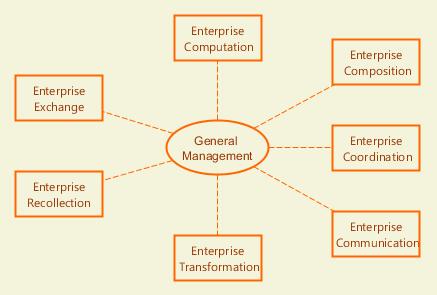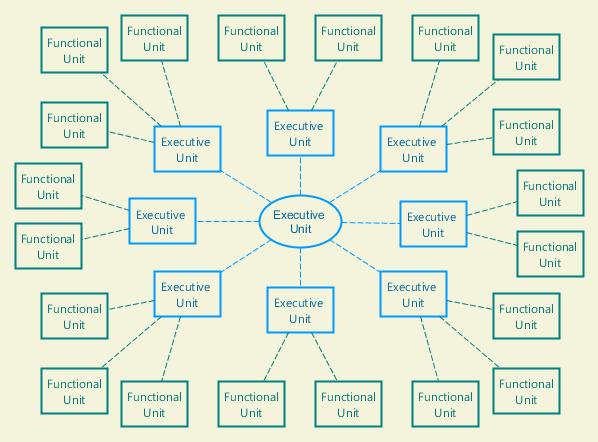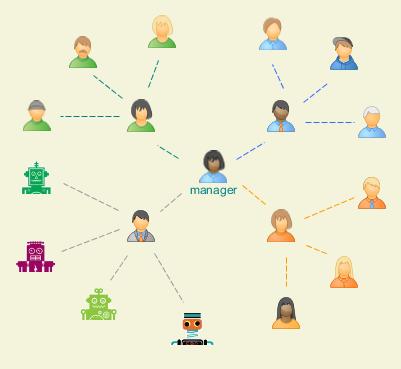Introducing the Enterprise Management Framework
by Andre MilchmanEnterprise Architecture is NOT an Information Technology issue... it is a Management issue.
- John A. Zachman
The Enterprise Management Framework (EMF) attempts to formalize, conceptualize and articulate principles related to the organization of the Enterprise in a simple and coherent framework and to apply this framework to enterprise engineering. The model intentionally liberates itself from the constraints imposed by Industrial Age management standards and adds principles focused on designing the Digital Enterprise.
The EMF covers the following aspects of enterprise management:
- Enterprise computation emphasizes the difference between the approaches to enabling computational and physical activities of the enterprise;
- Enterprise composition identifies the enterprise building blocks;
- Enterprise interchange defines a contract between the enterprise and the environment;
- Enterprise coordination synchronizes and integrates all enterprise activities toward achieving a common goal;
- Enterprise communication enables flexible real-time coordination of enterprise activities;
- Enterprise transformation frames the phases of enterprise reengineering;
- Enterprise recollection explains how enterprise information is represented, organized, stored, and retrieved.

1. Enterprise Computation
This principle means that any business, social, scientific, artistic, engineering, or design activities that deal with (create/modify/destroy/display) digital records, files, documents, software, video, audio, images, messages, or any other type of digital content are categorized as computation.
The EMF distinguishes computational activities from physical/chemical enterprise activities in order to highlight the need for designing new management models, adapted to the requirements of a modern-day digital enterprise.
In the case of artificial agents, computation is performed by software applications running on computer hardware.
Similarly, one can imagine human mind as
"software" that runs on the "hardware" of the brain.
Although the situation may change with the advent of brain–computer interfaces, modern-day humans cannot directly manipulate digital content and therefore rely on digital tools—desktop, web, and mobile applications—or digital personal assistants.
Today, Cloud Computing technologies provide the means for efficient and effective management, maintenance, and provision of infrastructure and platforms.
2. Enterprise Composition
Units create synergy between individual human and artificial agents in order to increase (1) intelligence (the ability to process information), (2) purposefulness (the ability to discover and satisfy the needs of others), (3) robustness (the ability to provide high quality of service), (4) autonomy (the ability to make decisions), (5) governability (the ability to be subjected to authority), (6) interactivity (the ability to collaborate, cooperate, and communicate with others), (7) adaptivity (the ability to learn and evolve), and (8) resilience (the ability to recover from errors).
When constructing artificial agents, we can discover other levels of scale—agent level, component level, and object level—however, those are the concerns of software design, not business design.
Functional units perform core activities that directly relate to the purpose of the Enterprise, whereas executive units ensure that the units under their authority contribute their best to the success of the whole.

Although most modern-day organization are complex hierarchies with more than two levels of scale and have human agents (SVP and above) at the top levels, in the 21st century this should be considered as a business design antipattern. In the age of hyper-fast, hyper-volume, and hyper-complexity information streams, human agents are not capable of (1) effective and efficient information processing, (2) making, exposing, recording, and learning from decisions, and (3) providing the desired quality of service. Therefore, they should become parts of stronger enterprise centers—units.

Purpose connects the unit to its customers. Function enables the customers to interact with the unit. Process is characterized by a set of operations that support the unit's Function. Structure is represented as a network of agents that play certain roles and perform various tasks within the Process. Culture is a collection of values, beliefs, and behaviors that energize the Structure.
Unity determines the unit's effectiveness—the ability to focus efforts toward a unifying purpose. Coherence means that the unit's Purpose, Function, Process, Structure, and Culture logically follow each other and create a unified and balanced whole. Cohesion ensures that every part of the unit is clearly linked to the next and establishes continuity within or towards other units. Completeness means that all digital constructs clearly and thoroughly support the unit's Purpose, Function, Process, Structure, and Culture.
3. Enterprise Interchange
Hierarchical relations are established between executive units on one side, and units under their authority (which could be either executive or functional) on another side. Collaborative relations can be established between all enterprise units who share information with each other, often by broadcasting. Exchange relations are typically established between enterprise units and the environment.
Austrian architect Christopher Alexander, author of The Pattern Language remarked that
a thick boundary is a kind of interchange zone.
Where two zones, lying side by side, have their own integrity, it is not enough to have a sharp edge to separate them.
In many cases, and especially in cases of living systems, there is a need for exchange, interchange,
flows passing across the boundary, subtle kinds of filtering, places where interaction of the elements coming from either side can take place.
Alexander believed that
in general it is necessary to think of boundaries as very large
.
In The Nature of Order: The Phenomenon of Life he wrote,
If the boundary
is very much smaller than the thing being bounded, it can't do much to hold in or form the center. A two-inch border cannot hold a three-foot field.
In a room, the boundary between floor and wall needs more than a six-inch molding - a wainscoting, 30 inches high, is more in scale with both.
An effective boundary for the river Seine consists of roads, walls, paths, quays, trees, something almost as massive as the river itself.
External facades of all enterprise units combined represent the public facade of the Enterprise, whereas internal facades combined represent the private facade of the Enterprise.
These interfaces can be realized as web portals or applications, mobile apps, microservices or APIs, etc.
Enterprise units produce combinations of services, products, or by-products. A service is an immaterial exchange of value that requires specific input from another entity and contributes to the achievement of its mission. A product is any digital content that is produced as a result of some process without a specific input of any particular entity. A by-product is any digital content that is produced unintentionally as a result of other process.
4. Enterprise Coordination
Traditional coordination mechanism, business process, has certain shortcomings if used for knowledge work activities. With the excessive focus on design-time activities (such as process modeling and simulation), Business Process Management (BPM) has not fulfilled the promise of agility, flexibility, and efficiency and was unable to achieve the desired levels of maturity in standardization and commercial applications. Worknet, the next generation coordination mechanism, breaks the traditional command-and-control model of management and shifts focus from design-time to run-time activities, which greatly improves agility and flexibility of knowledge workflows.
Command-and-control coordination is critical to the success of highly standardized production and administrative workflows. Expectation-based, event-driven coordination is more suitable for knowledge-based and relationship-based workflows.
5. Enterprise Communication
Asynchronous communication combined with standard mediation services minimizes interdependence and simplifies the integration of enterprise units.
While asynchronous communication increases autonomy, agility, and adaptability of enterprise agents, synchronous communication, which is simpler, faster and easier to use, will remain the preferred choice for many enterprise scenarios.
6. Enterprise Transformation
The first phase partitions the Enterprise into units capable of performing complex computational activities at desired service levels. The main challenge of this phase lies in eliminating human agents from the enterprise level, which might be perceived as loss of status by many. The second phase establishes thick boundaries around enterprise units in order to formalize their interactions with the environment. The third phase implements new coordination and communication mechanisms that minimize operational interdependence between units. Whereas the first three phases focus on the enterprise-level transformation, the fourth phase triggers the transformation of individual units, which can progress at an individual pace and rhythm.
